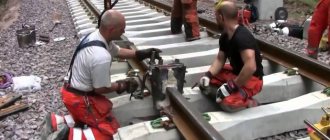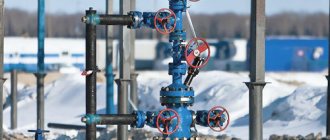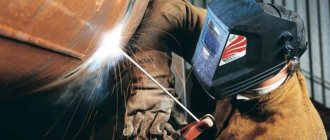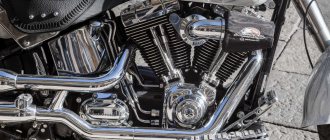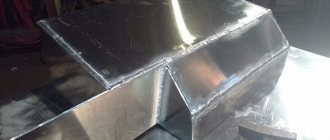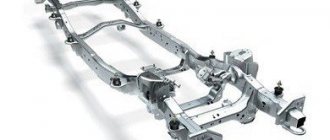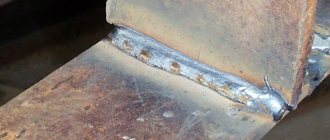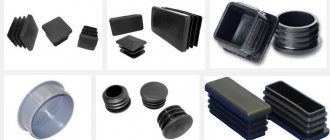Home / Welding technique
Back
Reading time: 2 min
0
1310
The preparatory stage is often more important than the work itself. Preparation for welding non-bending (non-rotating) seams is no exception.
Take a suitable tool and clean the welding area from all unnecessary debris, rust, paint residues. Then cut the pieces using a power tool or the thermal method, while keeping them together.
Based on the dimensions of our pipes, tacks are used to fix the workpieces, which resemble a welding seam.
- Introduction
- How to weld a horizontal joint
- How to weld a vertical joint
- How to weld a joint at a 45 degree angle
Method of working with a horizontal joint
The method of dealing with fixed pipeline joints in a horizontal position differs in that it is not necessary to completely cut the edges. These actions must be carried out using medium arc welding. You can only maintain an insignificant 10-degree cut. Such actions ensure an improvement in the process of joining metal parts and maintaining their quality at the same level. It is better to weld horizontal pipeline joints in separate, narrow layers. The root of the seam is welded with the first roller, using electrodes 4 millimeters in diameter. The force limit according to Ohm's law should be set in the range from 160 to 190 A. The electrode receives a characteristic reciprocating movement, while a thread-like roller 1-1.5 mm high should appear inside the joint. The coating of layer No. 1 must be thoroughly cleaned. Layer No. 2 is made in such a way that it covers the previous layer when the electrode moves in a reciprocating manner and when it swings almost imperceptibly between the edges of the upper and lower edges.
Table of the ratio of welding currents depending on various indicators
The direction of the second layer is no different from the first. Before performing the third layer, the current must be increased to 250-300 A. To make the process of joining metal elements more productive, you need to use electrodes with a diameter of 5 millimeters. The direction of cooking of the third layer is opposite to the directions of the previous two layers. The third roller is recommended to be performed at higher settings. The speed must be chosen so that the roller is convex. It is necessary to cook at a “back angle” or at a right angle. The third roller should fill two-thirds of the width of roller #2.
The fourth roller should be performed in the same modes as the third roller. The inclination angle of the electrode is 80-90 degrees from the surface of the pipe, which is located vertically. The direction of the fourth roller remains the same.
The technology for performing electric welding with horizontal joints in the presence of more than 3 layers has its own peculiarity: the third layer with all subsequent ones are performed in directions, each of which is opposite to the previous one. Pipes reaching a diameter of 200 mm, as a rule, must be welded with continuous seams. The reverse-step method is typical for the welding process of pipeline joints with a diameter of more than 200 mm. It is recommended that each section be approximately 150-300mm long.
Introduction
Be sure to ground metal parts such as the welding table, transformer base and other non-insulated devices.
Use electrical wires and cables with insulated coating. After welding the fixed pipe joints, take a hammer and chisel and remove any remaining slag. Then, if necessary, the seam can be smoothed with a grinder.
At the moment, 3 main methods of welding metal fixed fragments are used, which fundamentally determine the concept of operation of each of them:
- In a horizontal position;
- In a vertical position;
- At an angle of 45 degrees.
The choice of a specific method for welding fixed pipe joints must be based on:
- wall thickness;
- pipeline location;
- placement angle during welding.
Combining pipes using a three-layer seam is used if the thickness is 12 mm. Each seam should be no more than 4 mm high, and the width of the seam bead should be no more than three diameters of the conductor.
As the name suggests, rotary pipes can be rotated in the desired direction, making the welding process of non-rotating pipe joints easier and there will be no need to create complex seams (for example, ceiling ones).
Methodology for working with vertical pipeline joints without turning
The process of electric welding with vertical joints is similar to the process of working with horizontal elements. It must be carried out using short arc welding. The main difference is the need to regularly change the angle of the electrode, while simultaneously viewing it relative to the perimeter of the seam. The technological process of carrying out this type of welding is determined by the following main blocks:
- You need to “cook” the root seam in two passes. In the process of setting up the second roller, layer No. 1 must be melted - this ensures the quality of the root weld. The size of the pipe wall and the size of the gap between the connected components directly affects not only the pace of the process, but also the amount of current.
- The edges must be filled at a fairly high speed, while the electrode position is used at a "back angle" or 90 degrees.
- Locks of adjacent layers are carried out taking into account a shift of 5-10 mm. The length of the “lock” directly depends on the diameter of the pipeline.
- The flatness of the resulting surface largely depends on the welding rate; the facing layer is fused using narrow beads.
Sequence of seams for non-rotary welding
“Operational” seam during rotary welding of pipes
Sometimes the pipe is mounted too low or there is very little distance between it and the floor, making it impossible to get to the bottom. Then an “operational seam” is used to weld the pipes using the rotary method.
- Preparation.
Initially, it is very important to join the pipes evenly, chamfer and treat the area located near the seam. The welder has to face a more serious task if the work is carried out with a thin-walled (3 mm) galvanized pipe, because it burns like foil. In this case, the chamfers are removed quite a bit, leaving more blunting of the edges and a gap of only 1 mm.After joining and cleaning, a triangle or square is drawn on the pipe. It is precisely this “opening” that is required to carry out the planned operation.
You need to weld an electrode stub (or something else) to the triangle and cut out the intended shape using a grinder.
Then the pipes are joined with the required gap. Next, you can make tacks from the cut ends. But remember, if the pipe wall thickness is more than 4 mm, the gap must correspond to the diameter of the electrode rod.
- Welding and cleaning.
In this case, two methods are suitable for welding pipes using the rotary method: with or without arc separation. The choice depends on the circumstances, wishes and experience of the specialist.Welding begins with a crescent just above the bottom point of the pipe and ends at the tack joint. It is very important that the work is carried out until the edges are completely fused.
Next, a similar suture is applied on the other side. The first seam must be covered with a lock at the lowest point, so craftsmen recommend melting the lock longer.
Now you need to prepare the triangular cover and the area from which it was cut. First of all, the chamfer is removed and the area adjacent to the seam is treated. It is necessary to install the cover in place and make tacks, then clean the tacks and the place where work began - when welding pipes using the rotary method using this method, this area is considered the most important.
You can proceed to applying the first seam from the beginning of the indicated place and diagonally to the top of the triangle. When starting the second seam, it is necessary to clean the welding start area again.
On the other hand, all operations are performed in the same order. And now the seam is ready.
Welding a pipeline at a 45-degree angle
When performing this type of welding, the weld seam is located at a certain angle. It is formed only when a significant number of actions are carried out with the electrode: changing the direction of welding; changing the angle of inclination. This is the main feature of this type of welding, which, in turn, requires a certain level of professionalism and universal skills from the performer. This requirement especially applies to pipelines with high requirements for the tightness of welded elements. It is important to remember that the choice of technology for welding a pipeline at an angle of 45 degrees directly depends on the diameter of the pipes being welded:
- Gas pipes up to 200 mm in diameter need to be “cooked” in several layers in a row. For this purpose, during operation, the pipe is smoothly rotated as the weld seam is filled.
- When working with other types of pipes up to medium sizes in diameter, their circumference is divided into 4 segments and they are welded sequentially. After deposition of the metal of the first two segments, the pipeline is turned half a turn, after which work continues.
- The circumference of the pipe should be divided into a larger number of segments if work is carried out on a pipe of significant size (from 50 cm). The size of the segments should be from 150 to 300 mm.
Safety regulations
When starting to connect rotary joints of pipes or non-rotary analogues, you need to know that work of this type has a high level of danger. Therefore, certain requirements must be met.
Butt jointing of pipe products by gas or electric welding must be performed on specially equipped sites that have special equipment, including various means of protection against electric arcs. These elements are distributed so that people present nearby are completely isolated.
To connect tubular products with a large diametrical cross-section and a weight of over 20 kg, it is recommended to use special lifts. The entrance to the site must be cleared; its width cannot be less than 1 m. Operating temperature values in the room must be maintained within +160C. A prerequisite is the presence of a ventilation system and free space.
According to the technology for carrying out work involving the use of welding equipment, all metal parts and elements must be grounded (pro
Differences in the use of consumable and non-consumable electrodes
Welding work is carried out using consumable and non-consumable electrodes.
In the first case, the electrode itself and the area of the welded surface melt. When working with a non-consumable electrode, the arc mixes the molten metal of the surfaces being welded. Consumable electrodes:
- steel:
- copper;
- aluminum.
Non-melting:
- tungsten;
- coal;
- graphite.
Both types are used for welding copper pipes. It is a soft metal and difficult to weld.
Non-consumable electrodes are used for welding galvanized pipes.
The complexity of the work lies in the need to melt the zinc coating. To do this, the heating temperature must reach 1200 °C.
